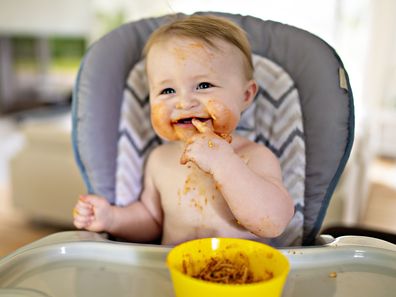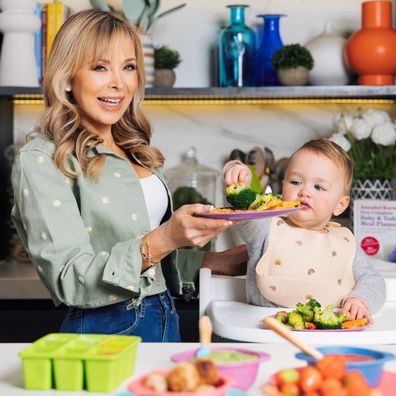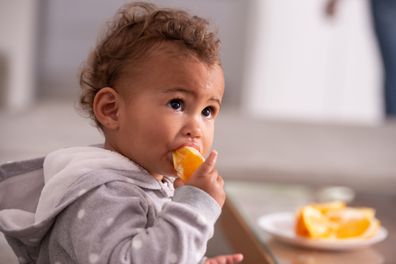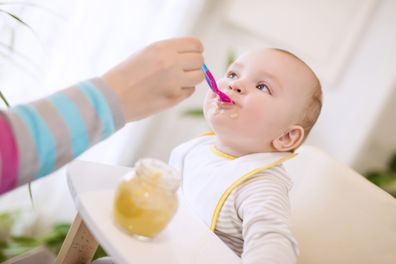BLW vs Pur¨Ĥe: An expert's view on what approach is best
By Annabel Karmel|
She has over 30 plus years of experience when it comes to feeding babies, so children's cookery author and food expert Annabel Karmel knows her stuff.
Though she also understands the stress and anxiety parents can experience when they begin to research the different methods of introducing foods to a baby.
And she is all over the arguments for and against both baby-led weaning (BLW) and pur¨Ĥe-based feeding. ?
READ MORE: How to get your hands on the traveller-approved Amazon backpack

"My mantra is simple - experiment with a wide variety of healthy foods and flavour combinations at the very start of a baby's weaning journey and you'll soon be in the road to weaning victory!"
So to help simplify the decision, and help parents decide on which approach, 9Honey Parenting turned to Karmel to share her expertise by answering your burning questions.
?What is BLW?
While lots of parents start out with smooth purees for spoon feeding, baby-led weaning is fast growing in popularity; a method which forgoes purees and spoon-led feeding.
Instead you simply let your baby feed themselves, starting with soft finger foods and family meals from six months.
They decide what foods they want to eat from what you offer and how much. Baby is very much in the driving seat!
READ MORE: Nick Jonas falls through hole on stage mid-show

The ethos behind this method is that babies are given the chance to explore a variety of foods, tastes and textures for themselves.
At first, your baby may just play with the food, but this is all part of their development. They will soon progress to sucking, chewing and swallowing.
For a daily dose of 9Honey, subscribe to our newsletter here.
What are the benefits of BLW?
Both spoon-led and baby-led weaning have their pros and cons. It really comes down to personal choice but here are some of the positives associated with baby-led weaning:
- Babies who are given the opportunity to explore a wide variety of foods for themselves from the very start could be less fussy later in life.
- Babies can learn a lot from handling food; from getting to grips with different shapes, sizes, sounds, weights as well as tastes and textures.
- It is thought that a baby is less likely to over-eat if they are allowed to choose what to eat from a range of nutritious foods. It also encourages babies to eat at their own pace and decide when they've had enough.
- Less time spent in the kitchen! Your little one is eating what everyone else is having which meansĦ less meals to prep. Plus, your meals will become healthier too.
READ MORE: The 30/30 rule that will help you stop impulse buying

Are there any concerns parents should have if they choose this approach?
The World Health Organisation recommend that babies start weaning at around six months in addition to their usual breast or formula milk.
Before six months, babies tend not to have developed the hand-to-eye coordination needed for baby-led weaning, so it's not an option if your baby is ready to wean slightly earlier than six months.
Again, premature babies who are advised to begin weaning earlier than the recommended 26 weeks are unlikely to manage baby-led weaning from the outset as they just won't be developmentally ready.
An important point to make here is that babies develop at their own pace. Many babies take to self-feeding like ducklings to water!
READ MORE: Save 35% on this barista-approved coffee machine
But other babies, particularly those whose motor skills are a little slower to develop, will find it difficult to eat useful amounts of food through self-feeding to begin with.
And this is ok. Remember ¨C your baby's milk feeds will still be providing the majority of their nutrition at this stage.
But once babies hit that six-month milestone, they start to need essential nutrients such as iron which cannot be fully gained from breast or formula milk alone.
This is where some form of pureeing or mashing of iron-rich foods such as chicken, red meat, eggs and lentils become important and baby quite simply may not be ready to manage these types of foods without a little intervention.
READ MORE: Survey reveals the thing now more important to Aussies than saving for a home
What does a pur¨Ĥe approach to solids entail?
When your baby first starts weaning, they are on a tasty, yet steep, learning curve.
Babies aren't born knowing how to manage solid food and the muscles in their mouth are only used to milk at this stage.
By starting with a smooth pur¨Ĥe, it allows for a gradual build-up of the strength of these muscles which is how they learn how to manage to move food around their mouth themselves.
As a result, spoon-led is often seen as a more gentle approach to weaning as it's a more gradual progression onto more textured solids.
However, it's worth noting that by waiting until your baby has reached six months, they will naturally be better at moving food around their mouth as well as chewing and swallowing.
READ MORE: Britney Spears reportedly splits from husband

This may mean that they progress slightly quicker and accept slightly more mashed and lumpier foods as well as finger foods at the very start of their weaning journey.
Having worked with lots of parents, the general feeling is that by offering their baby smooth pur¨Ĥes in those first couple of weeks, it gives them the initial confidence to then swiftly go on and introduce finger foods and more textured family meals.
How quickly can parents move from pur¨Ĥe to full finger food meals?
From six months you can introduce soft finger foods to your baby ¨C and finger foods are great for encouraging their independence, introducing texture and practicing that hand to eye coordination.
When it comes to introducing finger foods, they will need to be able to close their hand around the food so it's best to start with pieces that are big enough for your baby to hold in their fist with some sticking out.
READ MORE: Royal heading to Australia for World Cup clash
Fairly long pieces (roughly 5¨C7cm) stand a better chance of being picked up. Try avocado wedges, banana 'lollipops', mango slices, steamed carrot batons and broccoli florets for starters!
Can you do both?
Yes! I've always believed that you don't have to choose one or the other.
At around six months, you have the freedom to combine an element of baby-led weaning alongside spoon feeding if you feel that's right for you and your baby.
In speaking to parents, dietitians, nutritionists and healthcare professionals about the various approaches to weaning, combining both methods (purees and soft finger foods) - is the best option and one that many parents are finding the most realistic to adopt.
Not every baby's self-feeding skills are fine-tuned enough at 6 months to be able to pick up food and take it to their mouth, which is an important time to be introducing nutrient-rich foods which contain iron (which cannot be gained from breast or formula milk alone).
READ MORE: Up to 46% slashed off Dyson vacuums

This is where some form of pureeing or mashing of nutrient-rich food such as chicken or meat becomes important.
Both baby-led weaning and spoon-feeding allow your baby to explore a variety of different tastes, flavours and textures.
The important thing is to ensure a variety of foods (particularly much-loved family foods) and allow your baby to go at their own pace.
What's important is that there is no right or wrong to weaning. Some babies thrive on purees, others on finger foods and yet some on both.
Instead of committing to a certain feeding method, it's ok to be flexible in your approach and to follow your intuition and your baby's developmental signs.
Annabel's #1 rated recipe app is filled with over 700 simple and delicious ideas, PLUS new recipes every week. You'll also have exclusive access to meal planners, shopping lists, allergy tracker, and popular listen-along weaning guide. Start your FREE trial today on the App Store or Google Play.




